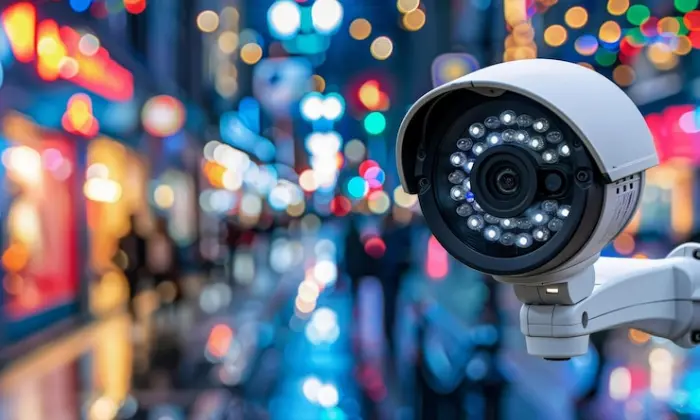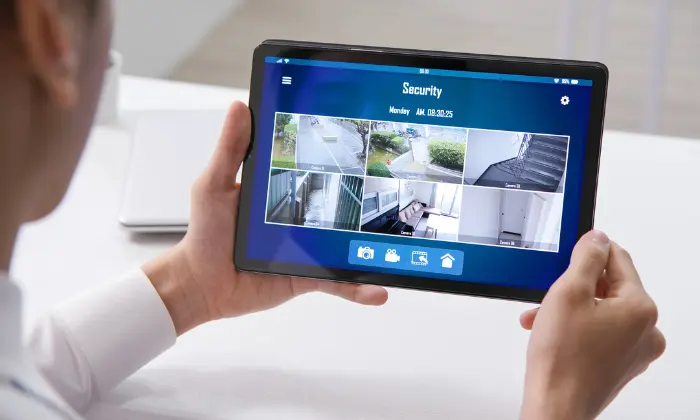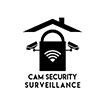Real-time video monitoring is changing the way businesses protect their assets. With live surveillance, you can keep an eye on your premises from anywhere, ensuring safety and efficiency at all times.This smart security solution uses high-definition cameras, AI-powered analytics, and instant alerts to detect suspicious activities, unauthorized access, or operational issues as they happen. Whether it’s preventing theft, stopping vandalism, or improving workflow, real-time monitoring provides 24/7 protection with instant response capabilities.
Perfect for retail stores, warehouses, and corporate offices, real-time video monitoring helps you stay in control and make smarter security decisions.
What is Real-Time Video Monitoring?

Real-time video monitoring involves the continuous surveillance of a location using security cameras and analytics software to detect and respond to incidents as they happen. A cutting-edge feature video content analytics (VCA) automatically processes video footage, identifying objects and detecting events using predefined algorithms.
This technology not only helps prevent theft and vandalism but also improves operational efficiency, reduces costs, and provides valuable insights into business performance, offering peace of mind to business owners.
Remote video access feeds lets businesses watch multiple locations from anywhere. They can use a smartphone, tablet, or desktop. With real-time alerts and video records, businesses can quickly react to suspicious activities, operational issues, or customer service needs.
How Does Real-Time Video Monitoring Work?

The process begins with the installation of high-quality cameras at key points across your property. These cameras continuously stream video footage to the monitoring center, where security experts watch over the feed 24/7. Here’s how CAM Security Surveillance ensures complete protection:
Constant Monitoring:
The team monitors your property round the clock, ensuring that no suspicious activity goes unnoticed. Whether it’s a trespasser or an unauthorized vehicle entering the premises, our live surveillance team is always on alert.
Immediate Response:
If any unusual activity is detected, the monitoring professionals can react instantly. This can involve using two-way speakers to communicate with intruders, activating security lights, or contacting local authorities to intervene.
Advanced Technology:
Real-time video surveillance systems often include advanced features like artificial intelligence (AI) and motion detection. These technologies enhance the system’s ability to recognize and respond to threats swiftly and accurately.
15 Ways Real-Time Video Monitoring Boosts Industries
While real-time video monitoring is primarily associated with security, its applications go far beyond simply protecting a business. Here are 15 ways industries can benefit from real-time video monitoring and how investing in this technology can boost their operations:
1. Enhanced Security and Loss Prevention
Real-time monitoring ensures that security issues, such as theft, vandalism, or unauthorized access, are detected as soon as they occur. Businesses can create special zones for close monitoring. This lets them get instant alerts for any suspicious activities. This significantly reduces loss, both from internal theft and external threats.
Advanced features like motion detection and video analytics automatically detect unusual activity. This system sends instant alerts to security personnel or law enforcement. This allows for immediate action, reducing the time criminals have to complete a theft or damage property.
2. Reduced Labor Costs
One of the biggest benefits of real-time video monitoring is that it cuts down the need for on-site security staff. Remote guarding through video surveillance eliminates the requirement for 24/7 security guards. Cameras provide continuous surveillance, helping businesses monitor activities without the high costs of additional staff.
Even when businesses use on-site security staff, real-time video monitoring helps them focus on important areas. By concentrating resources in the right places, businesses can optimize their security operations while keeping expenses low.
3. Immediate Response to Issues
Real-time monitoring provides instant alerts when an issue is detected, enabling businesses to respond immediately. Whether there is a security breach, equipment failure, or operational issue, managers can quickly access live footage. This helps them act to stop small problems from becoming bigger ones.
This proactive approach reduces downtime, loss, and even potential legal liabilities. For example, if an employee gets injured at work, quick video access enables management to see what happened. This helps them take the right steps to fix the issue.
4. Remote Monitoring Across Multiple Locations
With real-time video monitoring, businesses do not need to make regular visits to each location anymore. Cloud-based systems allow business owners and managers to watch all their sites from anywhere in real time. This applies to a single building or many locations in different cities.
This remote monitoring capability is invaluable for businesses with many branches or franchises. It saves time and makes sure operations run smoothly at all locations. You can see what is happening on the ground.
5. Better Asset Protection
For businesses with valuable inventory or sensitive information, real-time video monitoring is a key tool for protecting assets. Security cameras act as a visual deterrent for potential thieves, while live monitoring ensures immediate detection and response to any suspicious activity.
Real-time monitoring helps protect valuable assets in retail stores, warehouses, and offices. It offers instant video evidence that users can share with law enforcement when necessary. This ensures a fast and effective response to incidents of theft or damage.
6. Alarm Verification
False alarms can be costly and frustrating for businesses. With real-time video monitoring, alarm verification is possible, meaning trained professionals assess the situation before deciding if emergency services are necessary. This reduces the number of false alarms, avoiding fines and unnecessary disruptions.
When alarms go off, real-time video helps security staff see if there is a real threat or if it was a mistake. If necessary, authorities can share live video feeds directly with law enforcement, ensuring a faster and more informed response.
7. Improved Employee Performance and Retraining
By watching employee performance through live video feeds, businesses can find areas where training is needed. They can also see where employees may need extra support. For example, managers can easily find inefficiencies. These include time theft, which happens when employees do not work during paid hours. They can also spot mistakes that come from poor training.
Real-time monitoring also helps with employee safety and compliance with company policies. If we see a problem, like unsafe behavior or not following rules, we can fix it right away. This helps prevent accidents and keeps productivity high.
8. Operational Efficiency
In addition to enhancing security, real-time video monitoring can also improve overall operational efficiency. By integrating commercial security camera installation indianapolis video feeds with business systems, managers can track KPIs such as sales performance, foot traffic, and employee productivity.
For example, a retail store may use real-time monitoring to assess customer flow, staff allocation, and even merchandising effectiveness. Adjustments can be made quickly to address bottlenecks or improve sales, ensuring that the business operates smoothly and efficiently.
9. Improved Customer Service
Good customer service is essential for retaining clients and boosting revenue. Real-time video monitoring allows business owners to observe customer interactions with staff, ensuring that employees are adhering to service standards.
This can be especially useful in retail or hospitality environments, where quick and polite customer service is crucial. By identifying areas where customer service can improve, businesses can provide additional training to employees, ultimately enhancing customer satisfaction and increasing sales.
10. Lowered Liability Risks
Real-time monitoring helps businesses manage liability risks more effectively. Video footage can be used to verify claims in case of accidents or disputes, such as slip-and-fall incidents. This can help businesses avoid costly lawsuits by providing concrete evidence of the event.
Additionally, monitoring employee behavior in high-risk areas like warehouses or construction sites can prevent accidents and ensure that safety protocols are being followed, further reducing the risk of workplace injuries and associated costs.
11. Cleaner, Safer Facilities
Maintaining a clean and safe environment is essential for both employee well-being and customer satisfaction. Real-time video monitoring helps ensure compliance with cleanliness and safety standards by allowing managers to observe and address issues such as spills, clutter, or hazardous conditions before they pose a danger.
Clean facilities also deter theft and vandalism, as well-maintained environments are less likely to be targeted. Real-time video monitoring ensures that businesses can maintain a high standard of cleanliness and safety, minimizing the risk of accidents and improving the customer experience.
12. Reduced Inventory Shrinkage
Inventory shrinkage—whether from theft, mismanagement, or damages—can have a significant impact on a business’s bottom line. Real-time video monitoring helps detect and prevent inventory losses by allowing business owners to review footage of suspicious activity.
For instance, if a product goes missing, managers can quickly check video footage to determine if it was stolen, misplaced, or damaged. In retail environments, video monitoring is a key tool in reducing shrinkage and ensuring that inventory levels remain accurate.
13. Strengthened Law Enforcement Collaboration
Real-time video monitoring allows businesses to share critical video evidence with law enforcement when needed. If criminal activity occurs, high-definition footage can be quickly reviewed and shared with authorities, aiding investigations and increasing the likelihood of catching criminals.
Moreover, by building trust with local law enforcement through the provision of valuable video evidence, businesses can foster a better relationship with police, leading to faster and more thorough responses to future incidents.
14. Optimized Merchandising and Sales Strategies
In retail, understanding customer behavior is essential to creating effective merchandising strategies. Real-time video monitoring provides valuable insights into customer traffic patterns, allowing businesses to optimize product placement and store layout to maximize sales.
Heat maps, which show areas of high and low customer activity, help managers identify which products are drawing attention and which are being overlooked. By adjusting displays or rearranging merchandise based on real-time data, businesses can boost sales and improve the shopping experience.
15. Scalable Solutions for Growing Businesses
One of the major advantages of real-time video monitoring systems, especially those offered by CAM Security Surveillance, is their scalability. Whether your business is just starting or expanding across multiple locations, our systems can grow with you. As your security needs evolve, you can easily add more cameras, integrate additional features, or scale up to monitor new sites without disrupting your existing operations.
Real-Time Video Monitoring: Industries That Benefit
Real-time video monitoring is revolutionizing numerous industries. Whether your goal is enhancing safety, reducing liabilities, or improving operational efficiency, real-time monitoring provides the tools to help you stay ahead.
Here are 15 industries where real-time video monitoring is making a difference:
- Office Buildings
- Shopping Centers
- Apartment Buildings
- Self-Storage Facilities
- Automotive
- Distribution Centers
- Cannabis
- Restaurants
- Retail
- Manufacturing
- Construction Sites
- Banking
- Schools
- Convenience Stores
- Gyms, Fitness Centers, and Aerobics Studios
Here are some examples of how real-time video monitoring is benefiting these industries.
Office Building Real-Time Video Monitoring
Office buildings contain valuable equipment such as computers and specialized hardware, but outdoor real-time video monitoring provides the most significant advantages. Parking lots pose considerable risks, such as vehicle theft, vandalism, and accidents, potentially leading to legal liabilities for the building’s owner. Video monitoring in parking areas helps deter incidents and provides valuable footage to resolve disputes or claims. Additionally, monitoring entry points can detect potential break-ins before they occur.
Shopping Center Real-Time Video Monitoring
Shopping centers must address both individual store security and broader property management concerns. Real-time video monitoring serves as a powerful deterrent against vandalism and theft, especially during non-business hours. By alerting management to individuals lingering near closed stores, monitoring can prevent damage, reduce losses, and enhance overall security.
Apartment Building Real-Time Video Monitoring
In multi-family housing, real-time video monitoring enhances security while cutting costs. Instead of hiring additional security personnel, property owners can monitor entrances, hallways, and parking areas remotely. This proactive approach helps prevent vandalism, keeps residents safe, and reduces the need for costly physical security measures.
Self-Storage Facility Real-Time Video Monitoring
Self-storage facilities face liability risks, particularly from individuals attempting to live in storage units, which is illegal and dangerous. Real-time video monitoring allows facility managers to identify unusual activity, like people accessing units during off-hours, and intervene before legal issues arise. This system helps enforce security policies and protects both the facility and its customers.
Automotive Real-Time Video Monitoring
Car dealerships and automotive repair shops rely on real-time video monitoring to prevent theft, vandalism, and fraud. Monitoring vehicle lots and service areas can help dealerships protect their inventory without the need for physical barriers. For repair shops, video footage is crucial for verifying when and how damages occur to vehicles, reducing liability for false claims from customers.
Distribution Center Real-Time Video Monitoring
Warehouse security is essential for protecting both employees and merchandise. Real-time video monitoring helps ensure compliance with health and safety regulations, reducing accidents. It also helps prevent theft, particularly at shipping and receiving docks, where inventory can easily go missing. Monitoring outdoor areas ensures the safe arrival and departure of trucks, minimizing delays and accidents.
Cannabis Real-Time Video Monitoring
For cannabis businesses, real-time video monitoring is often required by law, but it also offers operational benefits. Dispensaries can use heat maps from video data to track customer behavior, optimizing product placement for increased sales. Security monitoring ensures compliance and deters theft in both dispensaries and cultivation facilities.
Restaurant Real-Time Video Monitoring
Real-time video monitoring in restaurants serves multiple purposes. It reduces theft, monitors service speed, and ensures compliance with health and safety regulations. Drive-thru operations benefit from real-time analytics, helping to increase the number of customers served during peak hours. Additionally, monitoring ensures that food is handled and stored safely, preventing health violations.
Retail Real-Time Video Monitoring
Retailers use real-time video monitoring to prevent shoplifting, employee theft, and merchandise damage. Monitoring POS systems helps identify internal theft, while cameras in storage areas ensure compliance with safety protocols. Slip-and-fall accidents can lead to costly legal claims, but video monitoring allows retailers to address potential hazards before incidents occur.
Manufacturing Real-Time Video Monitoring
Manufacturing facilities benefit from real-time video monitoring by ensuring worker safety and optimizing productivity. Cameras can identify potential hazards or inefficiencies in the production process before they cause widespread issues. Monitoring also ensures compliance with safety protocols, reducing accidents and maintaining operational efficiency.
Construction Site Real-Time Video Monitoring
Construction sites are vulnerable to theft, vandalism, and accidents, especially at night. Construction sites real-time video monitoring allows site managers to respond quickly to trespassers or potential hazards. Video alarms provide an additional layer of security, ensuring that police can be dispatched quickly if unauthorized individuals enter the site.
Banking Real-Time Video Monitoring
Banks use real-time video monitoring for more than just security. Visible cameras build trust with customers, making them feel safer when conducting transactions. Additionally, monitoring customer interactions allows bank managers to assess service quality, ensuring that customers leave satisfied.
School Real-Time Video Monitoring
School security cameras protect students, staff, and property. School real-time video monitoring helps administrators respond quickly to bullying incidents, theft, or vandalism. In the event of an emergency, such as a fire or active shooter situation, live video feeds can be shared with first responders to facilitate an effective response.
Convenience Store Real-Time Video Monitoring
Convenience stores face unique challenges, from theft prevention to compliance with laws governing alcohol and tobacco sales. Real-time video monitoring helps ensure staff and customer safety while deterring shoplifting and other crimes.
Gym, Fitness Center, and Aerobics Studio
Gyms often face membership-sharing issues, where individuals allow others to use their access cards. Real-time video monitoring paired with access control systems helps verify that the person entering the gym is the rightful member. This system also enhances security by ensuring that only authorized individuals access the facility.
Bottom Line
Real-time video monitoring improves security, safety, and operational efficiency across industries. By offering real-time alerts and proactive measures, video monitoring systems help businesses safeguard their assets, ensure compliance, and enhance customer and employee experiences. Whether it’s preventing theft, reducing liability, or optimizing service, real-time monitoring is a valuable tool for any organization.
Conclusion
Real-time video monitoring is no longer just an added security measure—it is a game-changing tool for businesses across industries. By integrating advanced surveillance technology, companies can enhance security, reduce costs, and improve operational efficiency. From retail stores and manufacturing facilities to office buildings and distribution centers, real-time monitoring provides business owners with instant insights and proactive security solutions.
With features like remote monitoring, AI-powered analytics, and immediate response capabilities, this technology minimizes risks, deters threats, and optimizes business performance. Whether you’re looking to prevent theft, improve customer service, or streamline operations, real-time video monitoring is the key to staying ahead in a rapidly evolving landscape.
At Cam Security Surveillance, we specialize in cutting-edge real-time monitoring solutions tailored to your industry needs. Contact us today to discover how our advanced surveillance systems can help protect your assets, enhance productivity, and provide peace of mind.
FAQs
What is real-time video monitoring?
Real-time video monitoring is a security solution that uses live camera feeds and analytics to detect and respond to incidents as they happen.
How does real-time video monitoring improve security?
It provides continuous surveillance, detects suspicious activities instantly, and allows immediate response through alerts or direct intervention.
Can I monitor multiple locations remotely?
Yes, cloud-based video monitoring enables businesses to oversee multiple locations from anywhere using a smartphone, tablet, or computer.
Does real-time video monitoring help reduce costs?
Yes, it reduces labor costs by minimizing the need for on-site security staff while also preventing losses from theft and operational inefficiencies.








